Across the field of human development development is defined
Across the field of human development, “development” is defined as: Question 1 options: Change across the lifespan. Universal and sequential. There are multiple definitions of development. Gains and losses. Save Question 2 (3 points) Question 2 Saved The traditional view of human development states that development is: Question 2 options: The biological unfolding of genetic potential. Any physical changes that occur between birth and maturity. Positive, normative, universal growth that occurs from conception to maturity. Gains, losses, and just plain changes that occur at each stage of the life cycle. all of the above. Save Question 3 (3 points) Question 3 Saved What is the biggest drawback of the life-span perspective of human development? Question 3 options: It overemphasizes positive development in old age. It is too different from the way that non-scientists think about development It relies too much on universal stages of adult development. It is difficult to figure out what should (or should not) be considered “development”. All of the above. Save Question 4 (3 points) Question 4 Saved There are several big picture meta-theoretical themes used in this class—as presented in the syllabus and textbook, and as explained by the instructor. Find the theme that is NOT part of the assumptions from the meta-theory used in this class. Question 4 options: Development is promoted by person-centered contexts and interactions. People carry the past forward into a dynamic present. Genetics are at the root of behavioral development. Development is influenced by an active changing context and an active developing person. All people face fundamental developmental tasks, although there are many healthy pathways through them. Save Question 5 (3 points) Question 5 Saved All psychological theories of human development deal with certain key developmental issues. These key issues include \"nature vs. nurture,\" and \"human nature as good vs. bad,\" as well as: Question 5 options: Cross-cultural universality versus context specificity; the continuity of development versus the discontinuity of stages. Infant as a blank slate versus the infant coming with stuff; adult as good due to social constraints or evil due to selifsh instincts. The nature of environmental stimulus versus an organism\'s responses; conditioned versus unconditioned responses. Individual existence versus personal stages of growth; collective everyday life versus historic ages of cultural evolution. Save Question 6 (3 points) Question 6 Saved What does it mean to say that \"development is contextually and historically embedded\"? Question 6 options: An individual\'s development takes place within a specific historical time. Development may differ for different generations. Societal context shapes people\'s development. As people live through history, these events change their pathways. All of the above. Save Question 7 (3 points) Question 7 Saved Some people have a mechanistic world view. They believe that: Question 7 options: People are active and bad, and development is quantitative and comes from heredity. People are active, good, bad, and changeable, and development comes from nature and nurture. People are passive blank slates, and development is quantitative (continuous) and comes from the environment. People are good and active, and development is stage-like (discontinuous). Save Question 8 (3 points) Question 8 Saved What is the \"model\" or root metaphor of the maturational world-view? Question 8 options: The battlefield The tennis match The butterfly The machine The tree Save Question 9 (3 points) Question 9 Saved The organismic world view includes the belief that: Question 9 options: People are active, good, bad, and changeable, and development comes from nature and nurture. People are active and bad, and development is quantitative and comes from heredity. People are passive blank slates, and development is quantitative (continuous) and comes from the environment. People are good and active, and development is stage-like (discontinuous). Save Question 10 (3 points) Question 10 Saved Dick and Jane think psychology is fun. They just read a book that says developmental psychologists often disagree over \"the nature-nurture issue.\" Dick and Jane know that the concept of \"nature\" in this ongoing debate includes: Question 10 options: Heredity and maturation. Natural, environmental and cultural influence. Learning and experience. Epigentics and ecology. Save Question 11 (3 points) Question 11 Saved The psychological theories of Erikson, Piaget, and Freud actually have much in common. They all agree that: Question 11 options: Development progresses toward greater maturity through distinct stages that are universal. The socio-cultural context plays a greater role in development than does individual agency. Development is both continuous and discontinuous; it can take many different directions, and proceed along many different paths. The role of the environment is greater than the role of the organism in development. Save Question 12 (3 points) Question 12 Saved \"Over the life-span, the human being progresses through eight psycho-social conflicts, from trust versus mistrust in infancy, to integrity versus despair in old-age.\" This is the central message of _________________ theory of development. Question 12 options: Sigmund Freud\'s Erik Erikson\'s Gilbert Gottlieb\'s Albert Bandura\'s Save Question 13 (3 points) Question 13 Saved Which of these theories fit into the contextual world-view? Question 13 options: Universal theories of Bowlby and Erikson. Stage theories of Kohlberg and Piaget. Learning theories of Skinner and Bandura. Systems theories of Vygotsky and Bronfenbrenner. Save Question 14 (3 points) Question 14 Saved Why should we care about how “good” research methods are? Question 14 options: If research methods are not good, we can’t believe the findings. Good research methods produce good evidence-based practices. Unless methods are good, we can’t get a fair test of alternative hypotheses. The better the methods, the more confident we can be in applying the findings. All of the above. Save Question 15 (3 points) Question 15 Saved In doing research, it is important to know the differences between \"findings\" and \"interpretations.\" What is the difference? \"Findings\" are ___________ whereas \"interpretations\" are ______________. Question 15 options: variable; unchanging scientific; unscientific truth; a series of conjectures information; what the information means substantiated; assumptions Save Question 16 (3 points) Question 16 Saved What is the greatest strength of the correlational method? Question 16 options: It can determine cause-effect relations. It can detect cohort effects. It can be used to examine issues that cannot be experimentally manipulated. It is not very complicated statistically. Save Question 17 (3 points) Question 17 Saved What is the greatest strength of the experimental method? Question 17 options: It is less time consuming than the correlational method. It can be used to examine individual differences. It can be used to determine cause-effect relationships. It is inexpensive. Save Question 18 (3 points) Question 18 Saved What is the greatest limitation of experimental studies in studying development? Question 18 options: Subjects are not randomly assigned to conditions. They are too complex to carry out correctly. Most of the causal variables of interest to developmentalists cannot be manipulated. They cannot detect cause-effect relationships. Save Question 19 (3 points) Question 19 Saved Standard experimental and correlational designs both have limitations for researching \"evidence-based practices.\" How can they be expanded to be more useful? Question 19 options: A) Expand correlational studies, so they include more than one time point. B) Use experimental designs to test out interventions designed to improve development. C) Take experimental studies out of the lab, and study \"natural\" experiments. D) All of the above. E) A & B only. Save Question 20 (3 points) Question 20 Saved In a(n) _______________ design, the researcher assigns people to treatment and control groups; whereas in a(n) __________ design the researcher examines existing relationships as they occur in real life. Question 20 options: longitudinal; experimental. experimental; correlational/naturalistic. sequential; correlational/naturalistic. cross-sectional; longitudinal. correlational/naturalistic; experimental. Save Question 21 (3 points) Question 21 Saved A school district is funding a variety of developmental research studies of students\' study habits. Which study is using a longitudinal research design? Question 21 options: A study that assesses the study habits of 5th graders this year, and plans to assess 5th and 6th graders next year, and then 5th, 6th and 7th graders\' habits the year after that. A study that assesses study habits in 5th graders this year, another group of 5th graders next year, and another group of 5th graders the year after that. A study that simultaneously tests the study habits of 5th, 6th and 7th graders today. A study that assesses the study habits in a group of 5th graders, and will follow and assess this same group when they get to 6th grade and 7th grade. Save Question 22 (3 points) Question 22 Saved A research study was conducted about changing musical likes and dislikes. One afternoon the researcher gave his \"Musical Taste\" questionnaire to a randomly selected group of young teens, older teens, young adults, middle-aged and elderly adults. This study was: Question 22 options: A longitudinal study. A sequential study. A cross-sectional study. An experimental study. Save Question 23 (3 points) Question 23 Saved A major disadvantage of the longitudinal method is: Question 23 options: It cannot tell us about changes in individuals. Subjects of the study drop out over time. The groups studied are too heterogeneous. It cannot examine the effects of earlier experiences on later development. Save Question 24 (3 points) Question 24 Saved For developmental researchers, a major disadvantage of the cross-sectional method is: Question 24 options: It cannot tell us about changes in individuals. It is time-consuming and expensive. Subjects of the study drop out over time. The groups studied are too similar to each other. Save Question 25 (3 points) Question 25 Saved The sequential design for studying development: Question 25 options: combines the longitudinal and cross-sectional methods. combines the experimental and the correlational methods. has the advantage of not requiring any repeated testing of individuals. simplifies the study of development by focusing on only one cohort. is the only correct design for studying life span development. Save Question 26 (3 points) Question 26 Saved Which design provides the most complete information for developmental research? Question 26 options: Cross-sectional Longitudinal Sequential Experimental Experimental Save Prenatal Development Question 27 (3 points) Question 27 Saved Which of the following is NOT a period of prenatal development Question 27 options: the Blastal period the Embryonic period the Fetal period the Germinal period Save Question 28 (3 points) Question 28 Saved In prenatal development, organogenesis refers to _________, whereas neurogenesis refers to _____________. Question 28 options: The formation of the internal organs; the formation of new neurons. The physical growth of the internal organs; the connectivity of the neural system. The formation of the internal organs; the connectivity of the neural system. The physical growth of the internal organs; the formation of new neurons. They both refer to the same growth process. Save Question 29 (3 points) Question 29 Saved In terms of creating problems in newborns, what is the most vulnerable period in prenatal development? Question 29 options: The Blastal period. The Germinal period. The Embryonic period The Fetal period. There is no period that is the most vulnerable. Save Question 30 (3 points) Question 30 Saved Imagine that a fetus has been exposed to a teratogen. In trying to predict the effects this is likely to have, what is the MOST important thing to know? Question 30 options: What is the sex of the fetus? How old was the mother at the time of exposure? What stage of development was the fetus in at the time of exposure? What is the weight of the mother? What is the social class of the mother? Save Question 31 (3 points) Question 31 Saved We have learned a great deal about the care and treatment of pre-term infants. Which one of these statements is WRONG? Question 31 options: Premature infants benefit from recent advances in medical care. Premature infants benefit from gentle stimulation. Premature infants benefit most if they are kept completely isolated in the isolette at all times. Premature infants benefit from “kangaroo care,” which is direct contact with parents’ bodies. All of the above statements are CORRECT. Save Question 32 (3 points) Question 32 Saved We have also learned a great deal about the long-term effects of prematurity. Which of the following statement is FALSE? Question 32 options: Premature infants are at higher risk for infant mortality. Premature infants are more susceptible to infections and brain damage. Premature infants can develop physical, attentional, learning, and behavioral problems. Findings from early research showing that premature infants had high rates of permanent developmental problems have been confirmed in recent prospective studies. Many of the early problems of premature infants disappear as they get older. Save Question 33 (3 points) Question 33 Saved There are many reasons why infants who born into poverty are more likely to be premature. Which one of these reasons is FALSE? Question 33 options: Mothers are more likely to experience higher levels of stress. Mothers are more likely to receive lower quality medical care. Mothers are more likely to be malnourished. Mothers are more likely to be older. All of these statements are TRUE. Save Question 34 (3 points) Question 34 Saved There are two kinds of premature infants: “pre-term” who are ________________; and “small-for-date” who are ______________. The kind of premature infant who seems most at risk for long-term problems are the _____________. Question 34 options: underweight for the number of weeks since they were conceived; born several weeks before their due date; pre-term. born several weeks before their due date; underweight for the number of weeks since they were conceived; pre-term. underweight for the number of weeks since they were conceived; born several weeks before their due date; small-for-date. born several weeks before their due date; underweight for the number of weeks since they were conceived; small-for-date. born several weeks before their due date; underweight for the number of weeks since they were conceived; they are at equal risk for long-term problems. Save Question 35 (3 points) Question 35 Saved What function(s) do(es) attchment serve in times of distress, danger, or trouble? Question 35 options: To bring the caregiver when the child is upset. To signal to the caregiver when the child is upset. To keep the child close to the caregiver when the child is upset. All of the above. Save Question 36 (3 points) Question 36 Saved Bowlby\'s ethological theory of attachment posits that attachment Question 36 options: is an automatic process that occurs without learning. is the result of mothers\' provision of food, which is a primary reinforcement. is an evolutionarily adaptive system that ensures the survival, protection and care of human young. can be accounted for by advances in children\'s cognitive capabilities. is associated with the gratification of infants\' innate drives to obtain pleasure orally. Save Question 37 (3 points) Question 37 Saved Ainsworth\'s perspective on attachment states that attachment is the result of a dynamic interaction between caregiver and infant. Which world-view does this theory belong to? Question 37 options: Contextual Maturational Organismic Mechanistic Save Question 38 (3 points) Question 38 Saved What do newborns come with that allows them to form attachments to their caregivers? Question 38 options: Sociability, crying Primary and secondary reinforcers Primary and secondary circular reactions Imprinting instincts Save Question 39 (3 points) Question 39 Saved Which part of the baby\'s behavior in the Strange Situation reveals the most about his/her attachment classification? Question 39 options: Exploration Reaction to stranger Separation from caregiver Reunion wirh caregiver Save Question 40 (3 points) Question 40 Saved In the Strange Situation, securely attached children: Question 40 options: explore when the caregiver is there and are distressed when separated from the caregiver. do not explore when the caregiver is present and are very upset when separated from the caregiver. stay near the caregiver and are not upset when separated from the caregiver. are upset when separated from the caregiver and cannot be comforted when s/he returns. could be any of the above. Save Question 41 (3 points) Question 41 Saved Typically, when infants with a resistant (anxious) attachment are at first separated and then reunited with their parent, they tend to: Question 41 options: act frightened when separated, and then act conflicted between approaching and avoiding the parent when reuinited. act extremely upset when separated, and then seek contact but seem to resent being left when parents return. act confused when separated, and then appear to be listless and go limp when parents return. act in a mildly distressed way when separated, but appear to be happy when reunited. Save Question 42 (3 points) Question 42 Saved Imagine an infant in the Strange Situation. When the caregiver returns, this baby doesn\'t seem to care and basically ignores the caregiver. What kind of attachment does this baby likely have? Question 42 options: Insecure-Resistant Insecure-Disorganized Secure Insecure-Avoidant Save Question 43 (3 points) Question 43 Saved In what type of family was the insecure-disorganized attachment category discovered? Question 43 options: Disorganized families. German families. Japanese families. High-risk families. Genetically at-risk families. Save Question 44 (3 points) Question 44 Saved An infant who is insecurely attached probably has a caregiver who: Question 44 options: is inconsistent. is not responsive. ignores the baby. lets the baby cry. could be any of above. Save Question 45 (3 points) Question 45 Saved Why do early attachments seem to have long-lasting effects? Question 45 options: Insecurely attached kids are not very physically attractive. The first bond determines all other bonds. Early attachments shape internal working models of relationships. Early attachments shape children’s permanent personality characteristics. Attachments do not really have long-lasting effects. Save Question 46 (3 points) Question 46 Saved Can children form attachments to more than one caregiver? Question 46 options: Yes, children usually form more than one attachment. Only in rare instances. Only if the first caregiver discontinues care. No, there can be only one primary attachment. Save Question 47 (3 points) Question 47 Saved What is a child’s “temperament” and when is it first detectible? Question 47 options: A child’s temper or negative emotionality; age 2 (the “terrible twos”). An infant’s inborn personality; at birth. A child’s emerging view of the world; at 12 months. An infant’s learned reactions to social and physical stimuli; first three months. A newborn’s sensory and motor capacities; at birth. Save Question 48 (3 points) Question 48 Saved In the most recent research by Rothbart, temperament is best defined as the nature of an infant\'s emotional reactions to environmental stimuli and: Question 48 options: the regulation of those reactions. how they affect the infant\'s development. goodness of fit. their relationship to adult personality. Save Question 49 (3 points) Question 49 Saved Which of these are temperamental dimensions? Question 49 options: Avoidant, resistant, disorganized. Sociability, adaptability, behavioral inhibition. Introversion, extraversion, openness to new experience. Cognitive, behavioral, emotional, social. These are all temperamental dimensions. Save Question 50 (3 points) Question 50 Saved An infant who will later become a behaviorally inhibited toddler displays which of the following when introduced to the new sights and sounds of a moving toy suspended above its bed? Question 50 options: Move arms and legs rapidly, begin to cry. Smile, laugh and coo. Stare intently with little emotion. None of the above (behaviors in infancy do not predict behaviors in toddlerhood). Save Question 51 (3 points) Question 51 Saved An \"easy\" temperament is best characterized as: Question 51 options: high sociability and low adaptability. high emotionality and high adaptability. high contentment and high adaptability. what is considered an \"easy\" temperament depends on the parents. high activity and low emotionality. Save Question 52 (3 points) Question 52 Saved Baby Billy-Bob has a difficult infant temperament. His parents try to be understanding and patient with him, but generally his behavior can be described in terms of: Question 52 options: moodiness, relative inactivity, and irregularity in daily routine. high levels of activity, but unresponsiveness to changes in routine. negative reactions to changes in routine, irritability, and difficulty being consoled. openness to new experiences, but irregular feeding and sleeping habits. Save Question 53 (3 points) Question 53 Saved When temperament researchers are added the concept of \"goodness of fit\" to their theories, they left one meta-theory behind and endorsed a new one. Which new meta-theory did they endorse. Question 53 options: The mechanistic meta-theory. The contextual meta-theory. The maturational meta-theory. The organismic meta-theory. Save Question 54 (3 points) Question 54 Saved What kinds of parenting are an especially good match for slow-to-warm children? Question 54 options: Providing structure and setting limits. Introducing them to new situations at their own pace. Insisting that they straighten up and act nicely. Ignoring their fears. Save Question 55 (3 points) Question 55 Saved What kinds of parenting are an especially good match for difficult children? Question 55 options: Providing structure and setting limits. Ignoring their tantrums. No kinds of parenting are really a good match for difficult children. Introducing them to new situations at their own pace. Telling them to straighten up and act nicely. Save Question 56 (3 points) Question 56 Saved For children with challenging temperaments, what are the long-term effects of a \"bad fit\" with parents? Question 56 options: Negative interactions between child and parent. The child\'s temperament gets worse. The child\'s temperament stays challenging. Could be any of the above. Save Question 57 (3 points) Question 57 Saved For children with challenging temperaments, what are the long-term effects of a “good fit” with parents? Question 57 options: The child’s temperament stays stable. Parents and children become more similar in temperament. Positive interactions between child and parent. All of the above. Save Question 58 (3 points) Question 58 Saved Parents who do NOT provide a good match for children with a difficult temperament: Question 58 options: probably have issues left over from their own childhood. are probably not adequate as parents. probably provide a bad match with all their children, regardless of temperament. None of the above; it is very hard to provide a good match with temperamentally difficult children. Save Question 59 (3 points) Question 59 Saved Piaget believed that cognitive development occurs as a result of: Question 59 options: the child\'s active interaction with the environment. the biological maturation of the human organism. selective reinforcement of appropriate responses. observational learning. the maturational unfolding of developmental tasks. Save Question 60 (3 points) Question 60 Saved Which phrase best describes Piaget\'s sensorimotor stage before the development of object permanence? Question 60 options: \"Be here now\" \"Out of sight, out of mind\" \"Do good, feel good\" \"No pain, no gain\" Save Question 61 (3 points) Question 61 Saved Mikey is three years old, and he has a black and white cat at home. While on his first camping trip, Mikey sees a skunk for the first time. He thinks the skunk looks like his cat and tries to pet the skunk, but the skunk sprays him. Mikey’s mother explains that that was not a cat but a skunk. Mikey now knows the difference between a cat and a skunk. Mikey’s new understanding--that a skunk is different than a cat--can be best understood in terms of Piaget’s concept of: Question 61 options: accommodation organization assimilation an operation Save Question 62 (3 points) Question 62 Saved Piaget\'s concept of adaptation can be defined as: Question 62 options: organizing one\'s thoughts. combining schemas to form more complex ones. adjusting to the demands of the environment. survival of the fittest cognitive schema. Save Question 63 (3 points) Question 63 Saved Jean Piaget\'s theory proposed four major stages of cognitive development. And at each and every stage of development, there are three processes at work: Question 63 options: adaptation, organization, and equilibration. schematic, sensory-motor and symbolic. pre-logical, concrete logical and equilibration. assimilation, accommodation and affiliation. Save Question 64 (3 points) Question 64 Saved What is the definition of equilibration? Question 64 options: Finding a place for existing schemes. Modifying existing ideas to better fit new experiences. Interpreting new experiences through existing filters (schemes). Process of searching for balance between cognitive structures and the environment. Combining existing schemes. Save Question 65 (3 points) Question 65 Saved The basis for an infant\'s very first interactions with the environment are: Question 65 options: cross-modal reactions primary circular reactions reflexes trial-and-error accommodations Save Question 66 (3 points) Question 66 Saved In terms of infants and very young children, it seems that Piaget\'s theory may have: Question 66 options: was exactly correct about their cognitive abilities did not mention their cognitive abilities overestimated their cognitive abilities underestimated their cognitive abilities Save Question 67 (3 points) Question 67 Saved According to the contextual perspective of how language develops: Question 67 options: a child\'s \"language acquisition device\" -- an inborn mechanism for mastering language -- is responsible for the development of linguistic skills. children\'s biologically based language competencies and their language environment interact to shape the course of language development. children are reinforced by getting what they want when they speak, and they achieve better approximations of adult language when parents praise meaningful speech. the child\'s biological maturation and genetically programmed capacities explain language development. Save Question 68 (3 points) Question 68 Saved According to the well known maturational (nativist) linguist, Noam Chomsky: Question 68 options: his own theory was in full agreement with B. F. Skinner\'s approach to language development. the child\'s biologically-based language competence and language environment interact to shape the course of language development. children are reinforced by getting what they want through the use of language. the child has an inborn mechanism for developing language skills, which he called a \"language acquisition device\" or LAD. Save Question 69 (3 points) Question 69 Saved Infants\' first communications with the social world are: Question 69 options: one-word utterances telegraphic speech crying gestures Save Question 70 (3 points) Question 70 Saved There are several communication milestones. Select the answer below that has them listed in the correct sequence from youngest to oldest. Question 70 options: Vocalizations, facial expressions, gestures, single words. Facial expressions, vocalizations, gestures, single words. Facial expressions, vocalizations, single words, gestures. Gestures, vocalizations, facial expressions, single words. Vocalizations, single words, facial expressions, gestures
Solution
Across the field of human development, “development” is defined as:
Question 1 options:
Answer: Change across the lifespan.
Answer: Across the field of human development, the development is defined as the prospects of changes in the cognitive aspects and age –related changes from embryonic phase to death in the form of changes across the life span
Question 2 Saved The traditional view of human development states that development is: Question 2 options:
Answer: all of the above.
Ques-60: Answer
\"no pain, no gain\" [The sensorimotor stage is the first of the four stages in cognitive development which \"extends from]
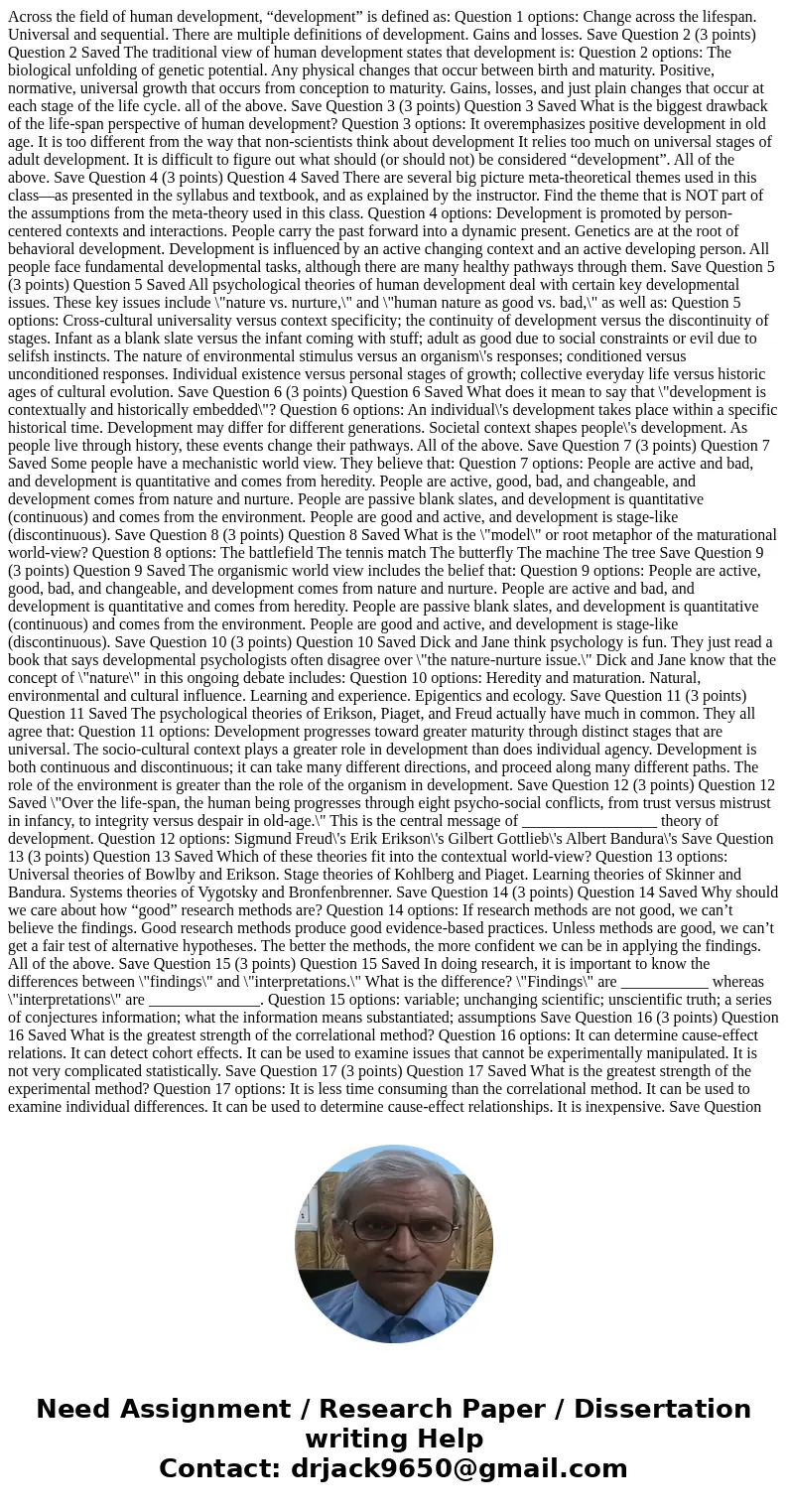
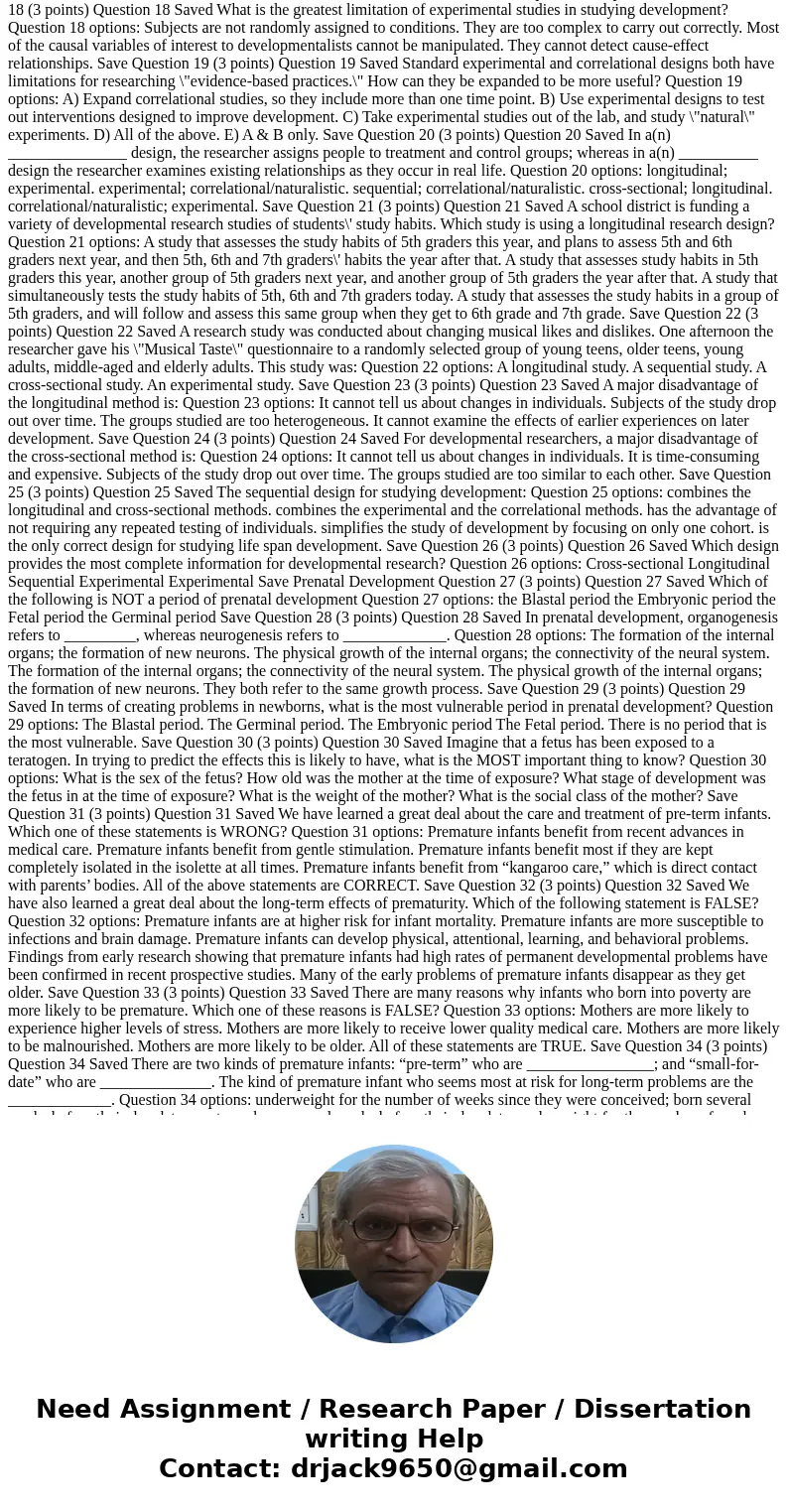
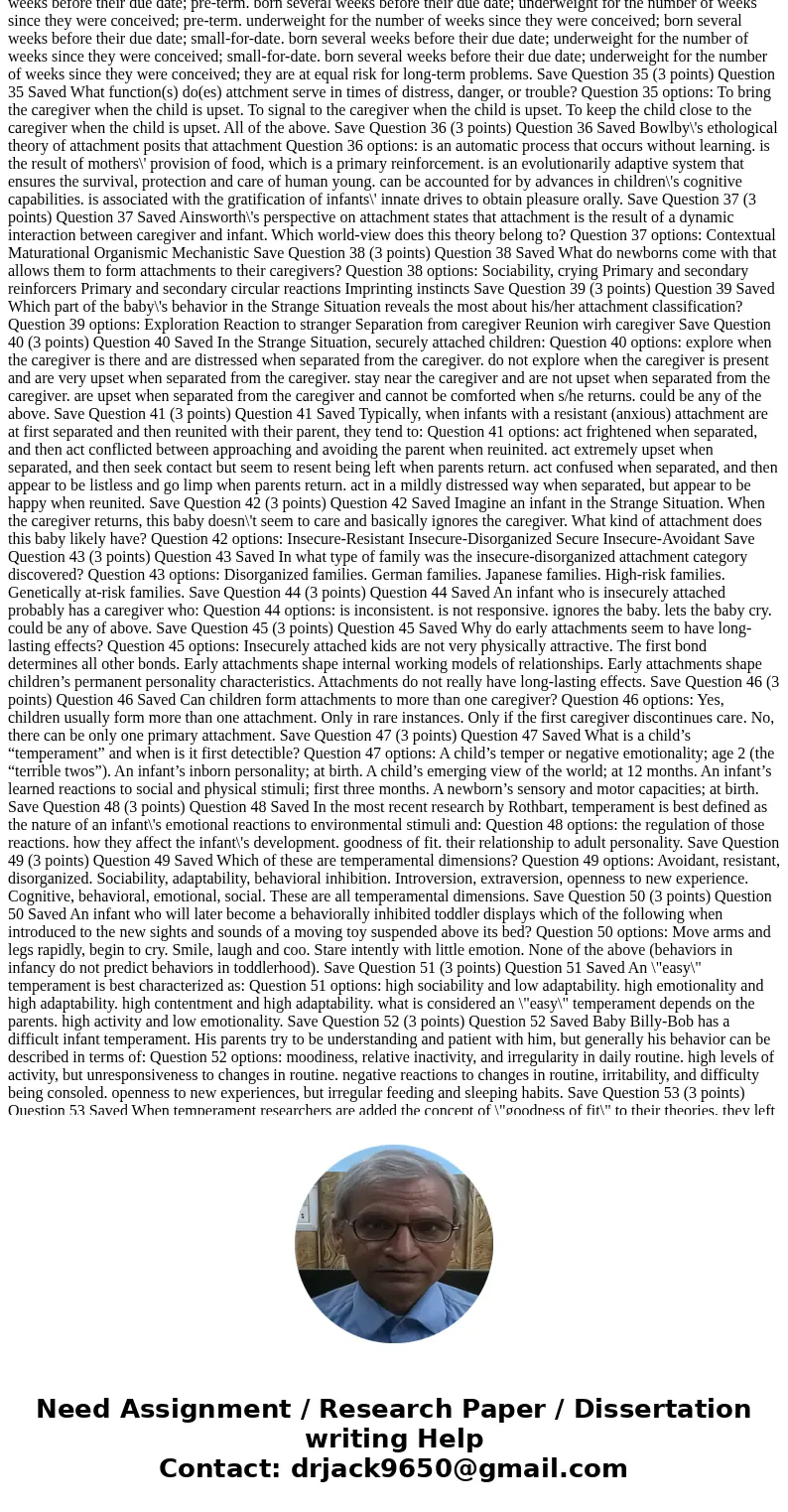
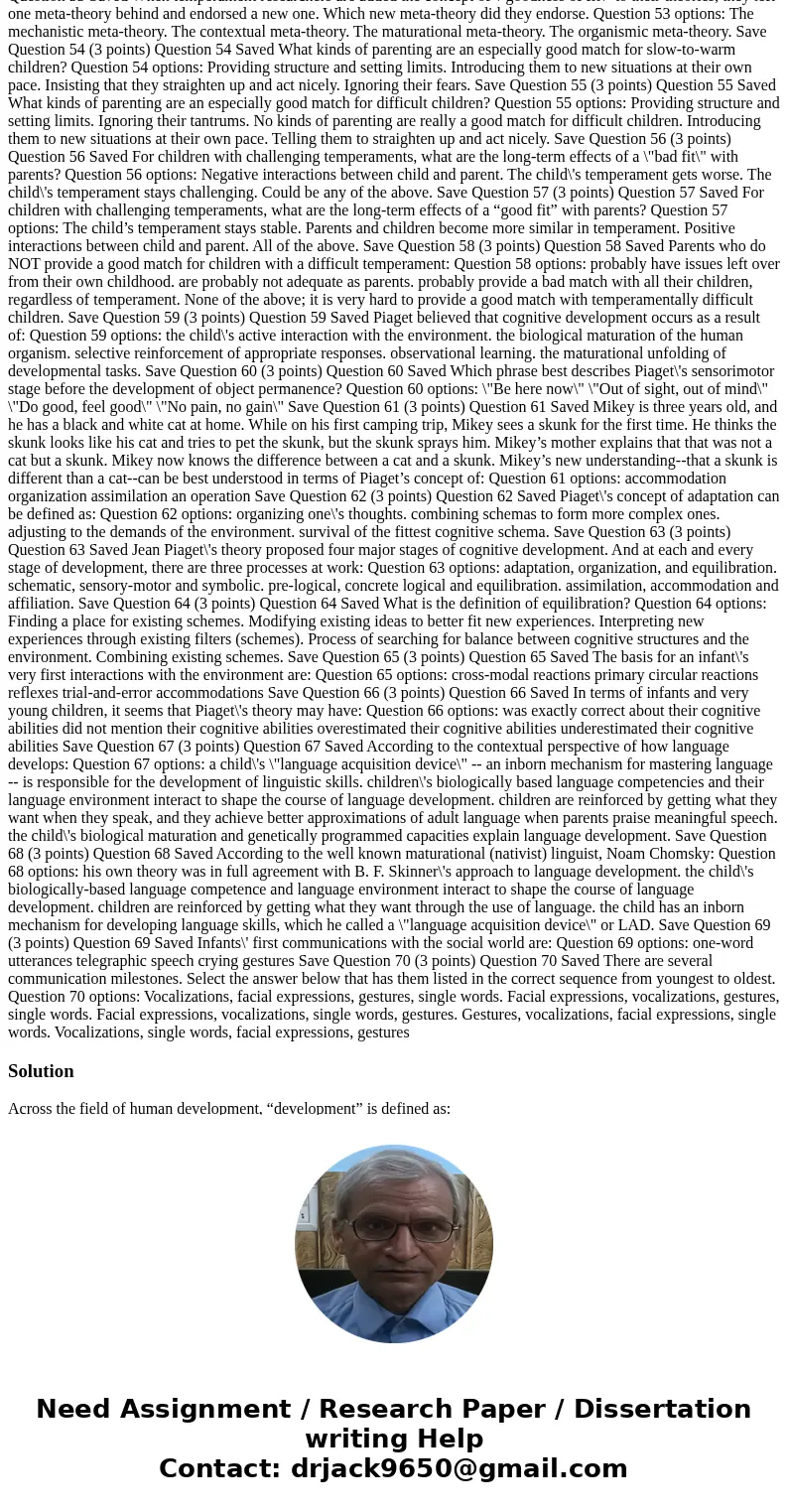
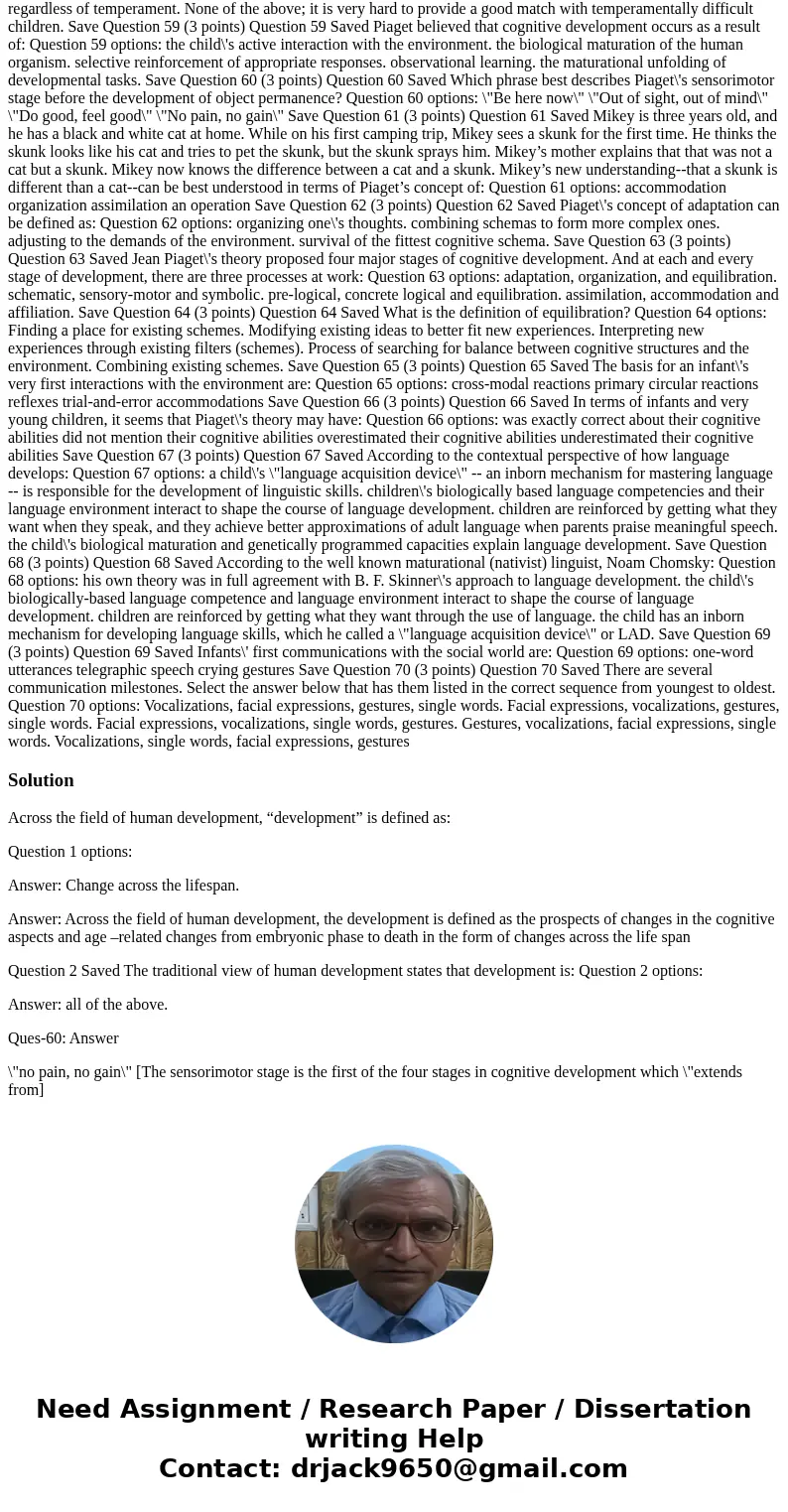
 Homework Sourse
Homework Sourse